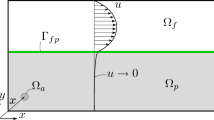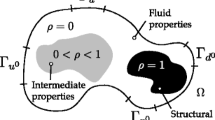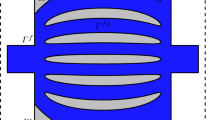Abstract
This paper presents some virtual element method (VEM) applications for topology optimization of non-Newtonian fluid-flow problems in arbitrary two-dimensional domains. The objective is to design an optimal layout for the incompressible non-Newtonian fluid flow, governed by the Navier–Stokes–Brinkman equations, to minimize the viscous drag. The porosity approach is used in the topology optimization formulation. The VEM is used to solve the governing boundary value problem. The key feature distinguishing the VEM from the classical finite element method is that the local basis functions in the VEM are only implicitly known. Instead, the VEM uses local projection operators to describe each element’s rigid body motion and constant strain components. Therefore, the VEM can handle meshes with arbitrarily shaped elements. Several numerical examples are provided to demonstrate the efficacy and efficiency of the VEM for the topology optimization of fluid-flow problems. A MATLAB code for reproducing the results provided in this paper is freely available at https://github.com/mampueros/VEM_TopOpt_FluidFlow.























Similar content being viewed by others
Data Availability Statement
The supplementary material (source code written in MATLAB) to this article can be found online at https://github.com/mampueros/VEM_TopOpt_FluidFlow. The code can be extended for other examples by modifying the input data. Moreover, the code inherits mesh data structure from PolyMesher [52] and VEM architecture from [51].
References
Borrvall T, Petersson J (2003) Topology optimization of fluids in Stokes flow. J Numer Methods 41:77–107
Gersborg-Hansen A, Sigmund O, Haber RB (2005) Topology optimization of channel flow problems. Struct Multidiscip Optim 30:181–192
Guest JK, Prévost JH (2006) Topology optimization of creeping fluid flows using a Darcy-Stokes finite element. Int J Numer Meth Eng 66:461–484
Wiker N, Klarbring A, Borrvall T (2007) Topology optimization of regions of Darcy and Stokes flow. Int J Numer Meth Eng 69:1374–1404
Pereira A, Talischi C, Paulino MIFMGH, Carvalho MS (2016) Fluid flow topology optimization in PolyTop: stability and computational implementation. Struct Multidiscip Optim 54:1345–1364
Challis VJ, Guest JK (2009) Level set topology optimization of fluids in Stokes flow. Int J Numer Meth Eng 79:1284–1308
Okkels F, Olesen LH, Bruus H (2005) Applications of topology optimization in the design of micro-and nanofluidic systems. Numer Algor 1:575–578
Olesen LH, Okkels F, Bruus H (2005) A high-level programming-language implementation of topology optimization applied to steady-state Navier-Stokes flow. Int J Numer Meth Eng 65(1):975–1001
Deng Y, Liu Z, Wu Y (2011) Topology optimization of unsteady incompressible Navier - Stokes flow. J Comput Phys 230:6688–6708
Kreissl S, Pingen G, Maute K (2011) An explicit level set approach for generalized shape optimization of fluids with the lattice Boltzmann method. Int J Numer Meth Fluids 65:496–519
Kreissl S, Pingen G, Maute K (2011) Topology optimization for unsteady flow. Int J Numer Meth Eng 87:1229–1253
Kreissl S, Maute K (2012) Levelset based fluid topology optimization using the extended finite element method. Struct Multidiscip Optim 46:311–326
Deng Y, Liu Z, Wu Y (2013) Topology optimization of steady and unsteady incompressible Navier - Stokes flows driven by body forces. Struct Multidiscip Optim 47:555–570
Romero JS, Silva ECN (2014) A topology optimization approach applied to laminar flow machine rotor design. Comput Methods Appl Mech Engrg. 279:268–300
Sá LFN, Novotny AA, Romero JS, Silva ECN (2017) Design optimization of laminar flow machine rotors based on the topological derivative concept. Struct Multidiscip Optim 56:1013–1026
Pingen G, Maute K (2010) Optimal design for non-Newtonian flows using a topology optimization approach. Comput Math Appl 59:2340–2350
Zhang B, Liu X, Sun J (2016) Topology optimization design of non-Newtonian roller-type viscous micropumps. Struct Multidiscip Optim 53:409–424
Hyun J, Wang S, Yang S (2014) Topology optimization of the shear thinning non-Newtonian fluidic systems for minimizing wall shear stress. Comput Math Appl 67:1154–1170
Alonso DH, Romero JS, Silva ECN (2020) Non-newtonian laminar 2D swirl flow design by the topology optimization method. Struct Multidiscip Optim 62:299–321
Zhang B, Liu X (2015) Topology optimization study of arterial bypass configurations using the level set method. Struct Multidiscip Optim 51:773–798
Romero JS, Silva ECN (2017) Non-newtonian laminar flow machine rotor design by using topology optimization. Struct Multidiscip Optim 55:1711–1732
Alexandersen J, Andreasen CS (2020) A review of topology optimisation for fluid-based problems. Fluids. 5(1):1–32
da Beirão Veiga L, Brezzi F, Marini LD (2013) Virtual elements for linear elasticity problems. SIAM J Numer Anal 51(2):794–812
Gain AL, Talischi C, Paulino GH (2014) On the Virtual Element Method for three-dimensional linear elasticity problems on arbitrary polyhedral meshes. Comput Methods Appl Mech Engrg. 282:132–160
Artioli E, Miranda SC Lovadini, Patruno L (2017) A stress/displacement Virtual Element method for plane elasticity problems. Comput Methods Appl Mech Engrg 325:155–174
Artioli E, Beirão da Veiga L, Lovadini C, Sacco E (2017) Arbitrary order 2D virtual elements for polygonal meshes. Computational Mechanics. 60(3):355–377
Chi H, Beirão da-Veiga L, Paulino GH (2017) Some basic formulations of the virtual element method (VEM) for finite deformations. Comput Methods Appl Mech Eng 318:148–192
Brezzi F, Marini LD (2013) Virtual element methods for plate bending problems. Comput Methods Appl Mech Eng 253:455–462
Wriggers P, Rust WT, Reddy BD (2016) A virtual element method for contact. Comput Mech 58:1039–1050
Rivera G, Mora D (2018) A priori and a posteriori error estimates for a virtual element spectral analysis for the elasticity equations. IMA J Numer Anal 2018:5
Benedetto MF, Caggiano A, Etse G (2018) Applications of the Virtual Element Method for cracking analysis of cement-based composites using interface elements. In: MECOM 2018. Tucumám, Argentina: Asociación Argentina de Mecánica Computacional; pp 2555–2566
Antonietti PF, Beirão da-Veiga L, Mora D, Verani M (2014) A stream virtual element formulation of the stokes problem on polygonal meshes. SIAM J Numer Anal 52(1):386–404
Cangiani A, Gyrya V, Manzini G (2016) The non-conforming virtual element method for the stokes equations. SIAM J Numer Anal 54(6):3411–3435
Beirão da Veiga L, Lovadina C, Vacca G (2017) Divergence free virtual elements for the stokes problem on polygonal meshes. ESAIM Math Model Numer Anal 51(2):509–535
Xin L, Jian L, Zhangxin C (2017) A nonconforming virtual element method for the Stokes problem on general meshes. Comput Methods Appl Mech Eng 320:694–711
Ernesto C, Gatica GN (2017) A mixed virtual element method for the pseudostress - velocity formulation of the Stokes problem. IMA J Numer Anal 37:296–331
Beirão da Veiga L, Lovadina C, Vacca G (2018) Virtual Elements for the Navier-Stokes problem on polygonal meshes. SIAM J Numer Anal 56(3):1210–1242
Beirão da Veiga L, Mora D, Vacca G (2019) The stokes complex for virtual elements with application to Navier-Stokes flows. J Sci Comput 81(2):990–1018
Beirão da Veiga L, Dassi L, Vacca G (2020) The Stokes complex for virtual elements in three dimensions. Math Models Methods Appl Sci 30(3):477–512
Xin L, Zhangxin C (2019) The nonconforming virtual element method for the Navier-Stokes equations. Adv Comput Math 45:51–74
Paulino GH, Gain AL (2015) Bridging art and engineering using Escher-based virtual elements. Struct Multidiscip Optim 51(4):867–883
Gain AL, Paulino GH, Duarte LS, Menezes IFM (2015) Topology optimization using polytopes. Comput Methods Appl Mech Eng 293:411–430
Antonietti PF, Bruggi M, Scacchi S, Verani M (2017) On the virtual element method for topology optimization on polygonal meshes: A numerical study. SIAM J Numer Anal 74:1091–1109
Suárez MAA, Romero JS, Menezes IFM (2018) Topology Optimization for fluid flow problems using the Virtual Element Method. In: MECOM 2018. Tucumám, Argentina: Asociación Argentina de Mecánica Computacional; pp 2037–2046
Zhang XS, Chi H, Paulino GH (2020) A virtual element approach. Comput Methods Appl Mech Eng, Adaptive multi-material topology optimization with hyperelastic materials under large deformations, p 370
Gartling DK, Hickox CE, Givler RC (1996) Simulation of coupled viscous and porous flow problems. Int J Comput Fluid Dyn 7:23–48
Cho Y, Kensey KR (1991) Effects of the non-Newtonian viscosity of blood on flows in a diseased arterial vessel. Part 1: Steady flows. Biorheology 28:241–262
Abraham F, Behr M, Heinkenschloss M (2005) Shape optimization in steady blood flow: a numerical study of non-Newtonian effects. Comput Methods Biomech Biomed Eng 8:127–137
Beirão da Veiga L, Brezzi F, Cangiani A (2013) Basic principles of virtual element methods. Math Models Methods Appl Sci 23(1):199–214
Beirão da Veiga L, Brezzi F, Marini LD, Russo A (2013) The Hitchhiker’s guide to the virtual element method. Math Models Methods Appl Sci 24(8):1541–1573
Chi H, Pereira A, Menezes IFM, Paulino GH (2020) Virtual element method (VEM)-based topology optimization: an integrated framework. Struct Multidiscip Optim 62(3):1089–1114
Talischi C, Paulino GH, Pereira A, Menezes IFM (2012) PolyMesher: a general-purpose mesh generator for polygonal elements written in Matlab. Struct Multidiscip Optim 45(3):309–328
Fish J, Belytschko T (2007) A first course in finite elements. Wiley, Hoboken
Shih TM, Tan CH, Hwang BC (1989) Effects of grid staggering on numerical schemes. Int J Numer Meth Fluids 9:193–212
Miller W (1995) Flow in the driven cavity calculated by the lattice Boltzmann method. Phys Rev E 51(4):1013–1026
Svanberg K (1987) The Method of Moving Asymptotes-A new method for Structural Optimization. Int J Numer Meth Eng 24:359–373
Kian JM (2017) Topology optimization method applied to design channels considering non-newtonian fluid flow [Master thesis]. USP—University of São Paulo. São Paulo, Brazil
Alonso DH, Nelli EC (2021) Topology optimization for blood flow considering a hemolysis model. Struct Multidiscip Optim 63:2103–2123
Brenner SC, Guan Q, Sung L (2017) Some estimates for virtual element methods. Comput Methods Appl Math 17(4):553–574
Funding
This work was supported by Conselho nacional de desenvolvimento científico e tecnológico (Grant no. 313833/2018-4).
Author information
Authors and Affiliations
Corresponding author
Additional information
Publisher's Note
Springer Nature remains neutral with regard to jurisdictional claims in published maps and institutional affiliations.
Appendix A: virtual element projections
Appendix A: virtual element projections
1.1 Virtual element projection \({\Pi }_E^0 \nabla v\)
Based on the works of Gain et al. [24], Beirão da Veiga et al. [50] and Brenner et al. [59], we consider the lower order element \((i.e., k=1,n_{p_{k}}=3\) and \(n_{p_{k-1}}=2)\) in which the set of basis functions for \(P_k (E)\), (linear polynomial space): \(m_\alpha ^{(k)},\alpha =1,\ldots , n_{p_{k}}\) is defined as
the gradients of \(P_k (E)\) are
and the basis functions \(\varvec{m}_\alpha ^{(k-1)}\), for the two-dimensional vector polynomial space \([P_{k-1}(E)]^2\) with \(\alpha =1,\dots ,n_{p_{k-1}}\) are defined as
where \(x_c\) and \(y_c\) are the coordinates of the centroid of the element E, |E| is the element area, and \(h_E=|E|^{1/2}\) is the average element size (Fig. 24).
The first projection operator \({\Pi }_E^0 \nabla v\), which projects the gradient of v onto \([P_{k-1}(E)]^2\), satisfies the orthogonality condition as
from the inner product and applying the divergence theorem, we have
By introducing a set of shape functions for the local VEM space \(V_h (E)\), \(\phi _i (x),i=1,\ldots ,n_v\), we can express \({\Pi }_E^0 \nabla v\) as
Therefore, Eq. (54) can be rewritten as
We can also express \({\Pi }_E^0 \nabla \phi _i\) using the set of basis \(\varvec{m}_\alpha ^{(k-1)}\) for \([P_{k-1}(E)]^2\) as
Finally, Eq. (56) can be rewritten as
From Eq. (58), we can form the matrices \(\varvec{M}\) and \(\varvec{R}\) and compute the matrix \(\varvec{S}\) as
1.2 Virtual element projection \({\Pi }_E^{\nabla } v\)
The second projection operator \({\Pi }_E^{\nabla } v\), projects v onto lineal polynomial space \(P_k (E)\), satisfies the orthogonality condition as
from the inner product and applying the divergence theorem, we have
We express \({\Pi }_E^{\nabla } v\) using the shape functions \(\phi _i\) as
Therefore, Eq. (60) can be rewritten as
We can also express \({\Pi }_E^{\nabla } \phi _i\) in terms of the set of basis \(m_\alpha ^{(k)}\) for \(P_{k}(E)\) as
By Combining Eqs. (62) and (63), we obtain
From Eq. (64), we can form matrices \(\varvec{M}^\nabla\) and \(\varvec{R}^\nabla\) and compute the matrix \(\varvec{S}^\nabla\) as
Additionally, we can express \({\Pi }_E^{\nabla } \phi _i(\varvec{x})\) in terms of the shape functions \(\phi _i\) as
and we can express the set of basis functions \(m_\alpha ^{(k)}\) for \(P_{k}(E)\) as
By substituting Eq. (67) into Eq. (63), we obtain
Then, \(\varvec{P}^{\nabla } = \varvec{S}^{\nabla }\varvec{G}^{\nabla }\), where
It is important to mention that \(m_\alpha ^{(1)} (\varvec{x}_i)\) indicates the \(\alpha\)th basis function for \(P_1 (E)\) evaluated at position \(\varvec{x}_i\) of the vertex i.
Rights and permissions
About this article
Cite this article
Suárez, M.A.A., Romero, J.S., Pereira, A. et al. On the virtual element method for topology optimization of non-Newtonian fluid-flow problems. Engineering with Computers 38, 5445–5466 (2022). https://doi.org/10.1007/s00366-022-01637-2
Received:
Accepted:
Published:
Issue Date:
DOI: https://doi.org/10.1007/s00366-022-01637-2





